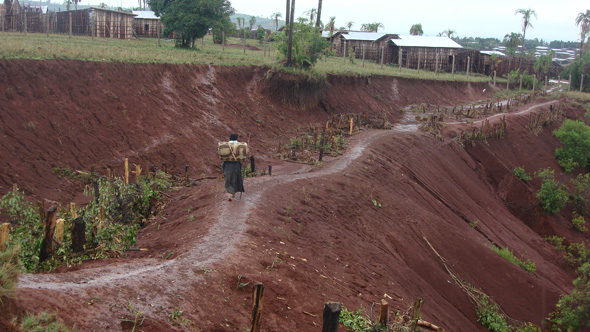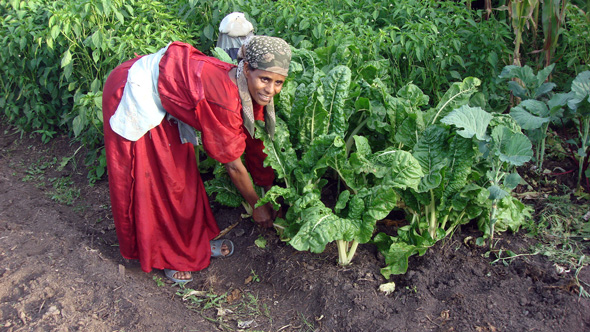-
Measuring Sustainable Development in Ethiopia’s Guraghe Zone
January 11, 2013 By Alexon Ayele
Despite progress over the years, Ethiopia’s Guraghe zone, located in the Southern Nations, Nationalities, and People’s Region, faces many development challenges. As senior monitoring and evaluation officer in the Guraghe People’s Self-help Development Organization (GPSDO), I have been working in this region for more than five years trying to reduce poverty and improve socio-economic development. The organization as a whole has been here for more than 50.
In 2008, GPSDO adopted a new holistic, participatory development approach where the community’s environment, health, and population dynamics are addressed in an integrated manner. With support from the David and Lucile Packard Foundation, this population, health, and environment (PHE) approach is currently being implemented in five of the nine woredas (districts) where GPSDO works.
GPDSO’s work addresses education, environmental protection, livelihood improvement, population dynamics, and child and women’s health. These challenges are highly interlinked, and through better monitoring and evaluation of our efforts, GPSDO hopes to show that an integrated PHE approach is better for community development in places like Guraghe zone than single-sector approaches.
Population, Health, and Environment Programming
The Guraghe zone has a high rate of poverty and faces severe erosion and environmental degradation. Families are large, resulting in high population pressure and unbalanced growth. The traditional belief is that having a lot of children is the main way to secure a livelihood in old age. But as land has been passed from generation to generation and families try to support themselves with smaller and smaller plots, traditional farming practices, such as fallowing, have been abandoned and the land has become degraded. As there is no longer enough farmland to pass to the next generation, this has led to an increase in migration as children look for employment in urban areas.
Annie Wallace on Scaling-up PHE in Ethiopia There are also health challenges such as lack of access to modern contraceptives, unsafe abortion, and sexually transmitted infections as well as diarrheal and other problems related to poor sanitation and clean water.
In our PHE programs, GPSDO combines several interventions to address these issues.
To address population dynamics, we have trained 100 volunteer community health workers who provide counseling and condoms and pills for those who are interested and work to raise awareness of the benefits of voluntary family planning and improve access to family planning services. These volunteers work closely with the Ethiopian government’s existing system of health extension workers and refer clients to them for other family planning methods and reproductive health services. We are focusing particularly on newly married couples to encourage them to delay their first pregnancy and to space their births.
GPSDO also works to address sanitation issues and supports various environmental conservation activities to rehabilitate eroded land. And we provide sustainable livelihood trainings that provide instruction on activities like bee hiving, backyard gardening, and making and using energy-saving stoves. Besides reducing deforestation, the efficient cookstoves are used to help empower women. As of our latest information, 183 women are making the stoves themselves and selling them for profit. They have distributed more than 2,500 fuel-saving stoves in less than two years.
Empowering women and girls is an important goal of our programming. We provide tutorial support for girls in school and support 250 housemaid’s access to night schooling.
For young people, GPSDO supports 90 PHE youth clubs – 50 in various schools and 40 out of school.
And to help restore the land, we teach agricultural best practices and conduct various physical and biological conservation activities, like area closure, constructing check-dams, establishing nursery sites, planting various fruit and forest seedlings, preparing flood diversion canals, and planting vetiver grass strips to prevent environmental deterioration.
Evaluating the Results
To help us evaluate the results of our PHE projects, we have developed an extensive monitoring and evaluation (M&E) framework and plan.
We try to evaluate not only the results and progress of each project toward its intended sectoral outcome but also the contribution of the results of one sector to the other (added values). This makes our M&E system for PHE projects different than what we are doing for other projects.
Some of the quantitative highlights of GPSDO’s results are:
- 49,784 women using a family planning method, contributing to an increase in contraceptive prevalence from 8.1 percent in 2005 to 33.46 percent in 2010
- 19,319 people given voluntary counseling and testing services for HIV/AIDS
- 246,600 mothers and children referred for maternal and child health services
- 1.2 million seedlings and 3 square kilometers of vetiver grass strips planted, which helps stop erosion
- 315 hectares of land rehabilitated and 206.5 hectares closed from human and animal interference to rehabilitate or conserve the area
Some of the added-value indicators we have measured include:
- 2,361 disadvantaged young girls or women that have started and or continued education
- 6,364 women that are able to diversify their livelihood options and are empowered socially as well as economically
- More than 1,500 fuel-efficient stoves distributed
- 30.2 percent of men support the use of modern contraception for themselves or their partners in one sample woreda with PHE projects vs. 7.3 percent for a sample non-PHE woreda
- 90 PHE youth clubs and 12 community structures strengthened and actively engaged in addressing PHE, gender, and reproductive health issues in the community
- 309 government officials, development agents, health extension workers, and others with knowledge of PHE integration
- 30 percent of communities in the project area receiving all three PHE elements
- 500 PHE-linked messages printed on gowns of teachers in 25 schools; more than 1,500 post cards and calendars with PHE-linked messages and illustrations; one Spotlight by the PHE Ethiopian Consortium
As Kristen Stelljes noted in her post in this series, our work was also recently evaluated comparatively by the PHE Ethiopia Consortium and Jimma University in Addis Ababa with funding from MEASURE Evaluation.
A survey was conducted in two different woredas – one where GPSDO was implementing a PHE project and another where we were only working on reproductive health. Interviewers surveyed 962 married women from October 2 to 8, 2012, about their knowledge and use of family planning methods, fertility preferences, income generation activities, their use of energy-saving stoves, and other topics. In-depth interviews were also conducted with GPSDO staff and partners, such as government officials working in health and agriculture in each district, health extension workers, and agriculture development agents.
What the researchers found is that the women who lived in the communities with PHE projects were more likely to be using family planning to limit the number of children they had and they wanted fewer children than their counterparts in the non-PHE woredas. They were also more likely to earn an income and use energy saving stoves, and their husbands were more likely to support their use of family planning.
This evaluation was the first of its kind in Ethiopia. As a result of the study and our own continued monitoring and evaluation, we now have evidence that the PHE approach results in better fertility behaviors than reproductive-health-only approaches.

Can Better Measuring Lead to Scale?
Despite these successes, GPSDO knows monitoring and evaluation for PHE projects is far from perfect. We would like to follow this evaluation up with further studies of our approach and better documentation of the work we are doing.
We are participating in several new initiatives through the PHE Ethiopia Consortium to better document PHE projects. This includes developed a set of shared PHE indicators, a process for capturing best practices, and collecting stories of community champions.
Through these efforts, we hope to continue to show the added value of the integrated PHE approach for community development over traditional single sector approaches. We also hope that with better documentation we will be able to convince partners and donors of the benefits of the PHE approach and enlist their support in scaling up our PHE efforts elsewhere in Ethiopia and to other vulnerable and disadvantaged communities beyond.
This post is part of a miniseries, “PHE Evaluation in Ethiopia,” on New Security Beat. Read the others here.
Alexon Ayele is the senior monitoring and evaluation and senior project preparation officer in the Guraghe People’s Self-help Development Organization.
Photo Credit: Erosion in Guraghe Zone and a farmer at work, used with permission courtesy of Alexon Ayele/GPSDO.
Topics: Africa, agriculture, community-based, conservation, demography, development, environment, environmental health, Ethiopia, family planning, featured, gender, global health, Guest Contributor, land, livelihoods, migration, natural resources, PHE, PHE Evaluation in Ethiopia, population, sanitation, video, water, youth
 A Publication of the Stimson Center.
A Publication of the Stimson Center.




